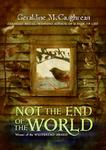
I began my career as a Sunday school teacher in the preschool. You didn't have to know anything to teach the littlies. You prepared a craft and a snack, sang some songs, and spent three years memorizing The Lord's Prayer with them. Some years the curriculum wasn't even particularly Biblical. Entire lessons might be developed around thanking God for your various body parts.
Nonetheless, we covered the story of Noah's Ark plenty of times. It's a story that's associated with little kids. There's kiddie Noah music, books, puzzles, puppets, jewelry, book marks, and probably lots of stuff I can't recall. I know that on at least two occasions I provided snacks in the form of a Noah's Ark made out of graham crackers stuck together with icing. Animal cracker critters were stuck into icing, too.
I feel uncomfortable about having done that now that I've read Geraldine McCaughrean's Not the End of the World. Whatever made me (or anyone else) think the story of the destruction of mankind was a fun tale for the kiddies?
In McCaughrean's take on Noah, Timna, his daughter, who knows she doesn't matter and won't be remembered (explaining why she isn't mentioned in the Old Testament), tells the first-person story of the days preceding and following The Wave. Their neighbors thought Noah and his sons were mad for building that giant boat until the water came. Then they begged to be saved--and were rebuffed. Those two older boys, Shem and Ham, were the muscle enforcing what they believed to be God's will. God was intent on destroying all mankind, and the boys believed their function was to help him.
This is a grim, apocalyptic tale that kept reminding me of Life As We Knew It. In addition to the horrific events surrounding The Wave--bodies floating in the water, people being murdered by Shem and Ham--life on the ark with limited food and dampness spoiling what they have is ugly. Not the End of the World definitely works as a disaster story.
In addition, poor Timna is both a doubter and someone desperately trying to believe. The book is being marketed to twelve year olds and up. Though McCaughrean is able to reconcile the brutality of Noah and his sons with a more loving God by the end of the story, it's going to take a mature, sophisticated reader to handle this material.
As an added benefit, you can do a feminist reading of this book. For instance, Timna is fourteen, her younger brother, Japheth (one of the three sons of Noah named in the Bible--I read the appropriate verses today) is twelve. The night before The Wave comes, Japheth's older brothers go out and kidnap a girl for him to marry down the road, since those three boys are going to have to do some serious repopulating when this thing is over. Does anyone think about a future mate for Timna?
This is definitely a good book. I did have some problems with the structure, though. Occasionally the first-person narrator switches from Timna to other family members. I didn't think that worked particularly well, especially with Timna's sisters-in-law. They both came off sounding like the lesser members of a teen bitch posse. One of them even kept saying "you know." Their voices didn't sound all that different, either. By the end of the book, these young women are well-defined, but because of what Timna says about them, not because of anything they say about themselves.
What I did like was when some of the animals did first-person narration.
I'd been wanting to read more by McCaughrean ever since I read Peter Pan in Scarlet. As it turns out, I read her A Pack of Lies a number of years ago. Even when I've been dissatisfied with certain aspects of her books--the narrator switches in Not the End of the World, the ending of A Pack of Lies--I've been very impressed with her work.
No comments:
Post a Comment